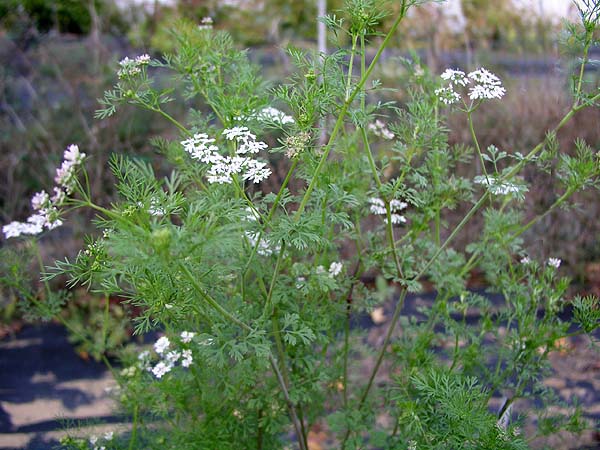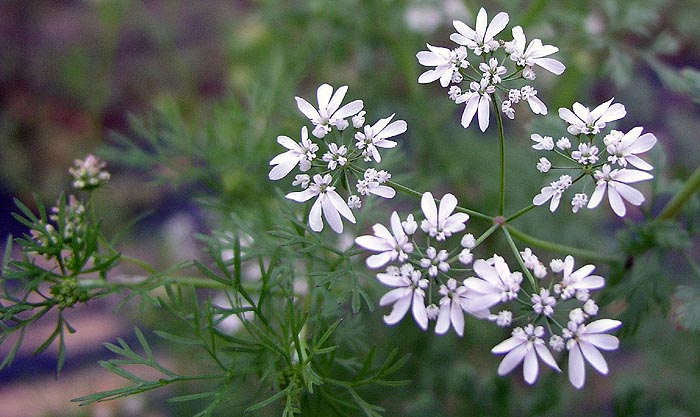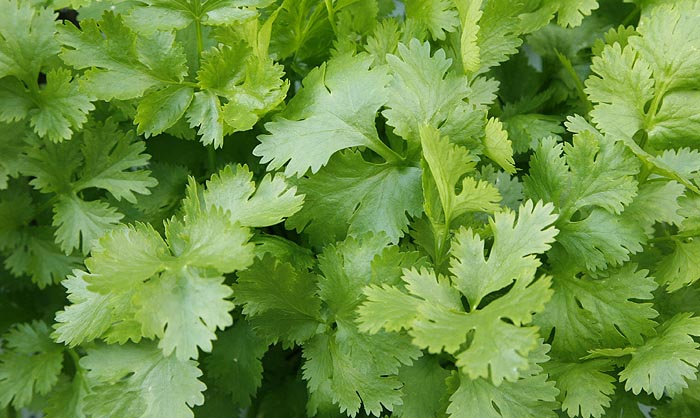This is a two-in-one herb. The leaf is known as Cilantro and the seeds are Coriander. Both have their own unique and distinctive flavor and are used in very different dishes. The plant itself is a delicate airy plant with lovely white flowers that is a delight in any garden. Although many say it's hard to grow, once you know the secret it's really pretty easy and an ideal way to get your own fresh herbs at low cost. It likes full sunshine and grows best in good rich well drained soil; it's a very short lived plant so resowing throughout the year is needed for a continuous supply of cilantro. Leave the plant to flower and you are rewarded with a mass of white blooms floating over fluffy white foliage that can brighten any garden. The butterflies like it too.
Description of Cilantro/Coriander (Coriandrum sativum)
Cilantro is a very short lived annual. It begins by producing a cluster of bright
green much dissected fern like leaves in a bushy cluster. These leaves have
long stems with small leaflets joined in opposite pairs to the central leaf
stem. Leaves can be extremely thin and fern like or wider and flatter. Both
sets of leaves can appear on the plant at the same time. After a few weeks the
plant sends up tall stiff green stems that can rise to 3 feet in height. Several
stems usually arise from each plant. These stems have fluffy leaf clusters at
intervals giving the plant a delicate but 'filled in appearance'. The tops of
the stems are crowned by loose open short stalked umbels of white flowers (sometimes
pink) that can reach about 3 inches across. The flowers are interesting in that
they have large lobed petals on the outside of the cluster but smaller short
ones on the insides. Many flower clusters appear at the same time making the
plant fairly showy. Flowers last about a week, sometimes two then fade and form
spherical yellowish brown seed pods that are ribbed and rough textured, and
about an eighth to a quarter inch in diameter. These 'seeds' which are called
coriander are actually little nutlets containing more than one true seed. The
whole plant is highly aromatic. The leaves have a very strong spicy aroma that
some people love and others find too strong. The seeds have an entirely different
aroma which some think have a disagreeable odor when fresh but dry to a much
more mellow fragrance that becomes stronger and more pleasant with age.
Is Cilantro hard to grow?
No. It can be extremely easy provided that you understand the nature of the
plant. It is VERY short lived, so it grows rapidly, bolts quickly and seeds.
It also produces a tap root which it does not like having disturbed so transplanting
cilantro must be done with extreme care. Many sites will tell you to start them
indoors, in cold frames and all other kinds of methods; we have tried a lot
of different things and found only one method really gives us good results.
Growing Cilantro or Corriander (Coriandrum sativum) from seed.
Plant it directly in the ground where you want it to be. Cilantro does best
in cooler weather so growing in the spring and the fall are the best times.
However it can be grown in summer if a location is chosen that has shade during
the hottest time of the day. More shade will be needed in warmer zones. We successfully
grow cilantro all through the year here in zone 6b/7a using shade at the hottest
part of the day during the summer. Summer grown plants will bolt much faster
as they don't like the heat but with care leaves can be grown and harvested
on a continuous basis if required. It does better in cooler weather and will
produce larger better leaves in cooler weather and more seed from plants grown
in fall.
Location and Bed Preparation for Cilantro (Coriandrum sativum).
Prepare a bed with a good deal of organic material worked into it. Cilantro
likes a good rich soil that is well drained. If good soil preparation is done
then no further fertilization is required during the year. We recommend watering
using a soaker hose to give even moisture daily if possible. See herb
bed preparation for more information..
For spring and fall plantings pick an area in full sun. Seed can either be sown
in a row or in small holes in mulching fabric for better weed control. If growing
in a row open a line in the soil about one inch deep and plant seeds about one
inch apart. Dense spacing gives a stronger leaf base and keeps weed competition
down plus it makes for easier harvesting. For mulch holes plant 2-4 seeds in
a hole depending on the size you have chosen to create. Be aware that each 'seed
pod' contains more than one seed so for each 'seed' you plant you may get 2-3
actual plants.
Water daily to provide even moisture. Seeds usually germinate within 7-20 days.
In spring sow after the danger of frost has passed and the soil has warmed into
the 60 F (15 C) mark. If using black mulch sowing can be slightly earlier since
the mulch will warm the soil. Depending on your location seeding can continue
until about 6 weeks before frost if leaf production is the desired crop.
For a continuous supply of fresh leaves the seeds should be planted every few
weeks. However do not keep reseeding cilantro into the same area that the last
crop was taken from. Move the plants to a different location as the first plants
will have depleted the soil of the nutrients essential to that plant.
The plants also need to be watched and harvested for leaves before they begin
to bolt. If seed is required - either for replanting or for coriander leave
the plants to flower. They are very attractive and the butterflies and native
bees love them.
Transplanting Cilantro (Coriandrum sativum).
Cilantro does not really like to be messed with. If, however, you need to move
plants around or have chosen to start them indoors make sure you don't disturb
the roots when you move them. Transplanting should only be undertaken for
very small young plants. Older plants never seem to survive. For garden
transplants, ensure you dig up a large chunk of soil around the plant. For pot
plants ensure that the plant is removed from the pot with all the soil intact.
Never shake soil from the plant and transplant bare rooted!. Dig a large hole
and place the plant with all the soil in the center and fill in around it. Water
in well and daily from then on. If plants become stressed they will bolt much
faster and you won't get many leaves. Remember these plants are short lived,
2-3 months at the most. Don't be upset if your plant does not last long, it
was not intended to.
Diseases and problems of Cilantro (Coriandrum sativum).
Cilantro is a fairly disease free crop, however it is susceptible to damping
off and bacterial wilt especially if seeds are started indoors.
Bacterial leaf spot Pseudomonas syringae is the most important disease
of cilantro. Symptoms consist of angular, vein-delimited leaf lesions that are
at first water-soaked or translucent. Over time and with drying conditions,
the leaf spots may turn black or brown. If infection is severe, leaf spots may
coalesce and cause a blighting effect.
This is a seed borne pathogen. Contaminated seed is an important means by which
the disease spreads and establishes itself. Splashing water enhances development
and spread of this disease, so rain and sprinkler irrigation favor the pathogen.
Harvesting Cilantro
(Coriandrum sativum).
The leaves of this plant are known as cilantro
(the seeds as coriander). Harvesting
of the leaves can begin when the plant is about 6-8 inches tall. Many people
cut off a few leaves at one time, and if that's all you need it's a good way
to go. Cut the older leaves from the outside of the plant and it will produce
new ones. However cutting leaves usually causes the plant to bolt more rapidly.
The plant can be cut down to almost ground level when the leaves harvested and
the plant may regrow a new set of leaves. However the second leaf set is never
as good as the first.
We recommend that the plant is pulled out of the ground once the leaves have
reached maximum leaf desirability. This process increases the shelf life of
the harvested leaves and also allows the roots to be used.
For the best taste your cilantro should be harvested at the coolest time of
the day, either first thing in the morning or later in the evening, we suggest
morning as the optimal time. The leaves are then best stored in a refrigerator.
For plants that have been pulled out by the roots, shake as much soil off as
possible and place in a plastic bag roots first. Placed in a refrigerator the
leaves can last for 14 days or more. Since they have a high water content avoid
cold areas of the refrigerator that may freeze the leaves.
If a refrigerator is not an option, place plants in water in a cool place away
from strong sunlight. Plants can last several days.
Harvesting Coriander (seed) (Coriandrum sativum)
If Coriander is desired allow the seeds to bolt, flower and seed. When the seeds
have turned a light brown color the plant's seed areas can be cut off with snips
or scissors. Seeds can then be shaken from the branches and any twigs left removed
by hand. Place in a tray (a flat cookie tray is ideal) on a piece of kitchen
paper for a few days to ensure that the seeds are fully dry before storing in
an air tight container. Store in a dark cool location for best long term storage.
If the seeds are required for planting next year do not dry out but place the
seeds in a container in the refrigerator until next spring's growing season.
Longer term storage of Cilantro.
For longer term storage cilantro can either be dried or frozen. Whatever you
choose, wash your crop first! Shake water off then either dry herbs or freeze
them. Bunched herbs can be placed in freezer bags and popped into the freezer
for instant usage.
For drying, herbs can be bunched up and then hung to dry in a warm dry area.
A loft or roof area is ideal. Hang the drying herbs up as high as possible away
from any animals (such as dogs cats or possibly mice). Once the herbs are dry
they can be crushed from the stems and stored in air tight jars in a dark location.
If you have a dehydrator place herbs in there and dry quickly. We recommend
this method as the best way to effectively dry herbs.
Edible uses of Cilantro (Coriandrum sativum).
Fresh leaves (cilantro) is used in a multitude of dishes. Cilantro is probably
the most widely used flavouring herb in the world. from flavoring salads, soups
and of course salsa. Its uses are almost endless.
The seeds (coriander) are also widely used especially in Indian and Eastern
cuisine. The fresh seed has a disagreeable and nauseous smell, but when dried
it becomes fragrant, the longer it is kept the more fragrant it becomes.
Caution.
Large dosages of cilantro have been shown to cause some liver damage. Overuse
of the seeds can have a somewhat narcotic effect. Some people find that handling
the fresh herb for more than short periods can cause a skin reaction or even
a rash. Dry coriander can also irritate the lungs especially in those suffering
from bronchial asthma and chronic bronchitis.
Medical uses of Cilantro (Coriandrum sativum).
For most cases it is the seed - Coriander - that is used medicinally. It is
very effective in treating digestive problems such as flatulence and diarrhea.
Coriander water was once most esteemed as a carminative for windy colic. It
can settle gut spasms and counter effects of nervous tension. It is most often
used with other herbs in order to disguise its taste. The seeds are also used
in a poultice to help with rheumatic pains, although often essential oils are
now used instead.
Cilantro has recently been found very effective in helping to remove heavy metals
from the body.
Other Uses of Cilantro (Coriandrum sativum).
A spray made by boiling one part coriander leaves and one part anise seeds in
two parts water is very effective against red spider mites and woolly aphids.
Oils are also used in soap making, food flavouring and perfumery.
History
Cilantro is one of the oldest herbs to be used by mankind, perhaps going back
as far as 3000 BC. It is mentioned in early Sanskrit writings dating back to
1500 BC. The seeds have been found in the tombs of the Egyptian pharaohs and
in Grecian ruins from the Bronze Age. It was brought to the British colonies
in North America in 1670 and was one of the first spices cultivated by the settlers.
Cilantro is also known as Chinese parsley









